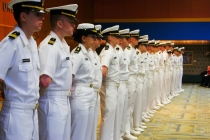Cutbacks
Two focal events shaped the immediate future of the NROTC unit in the late 1980s and early 1990s: the never declared "Cold War" with the Soviet Union finally coming to an end, and the American economic situation showing signs of President Reagan's military overspending, a major factor in pressuring the Communist country into a virtual bankruptcy and downfall. Just as in the late 1940s after World War Two, the military took a severe cutback on all expenditures, and a specific bill was passed in 1988 that cut into the NROTC scholarship program dramatically. At the same time, though, the Nursing program was reinstituted back into the Battalion in 1989, and it was also made possible to enter the restricted line communities such as Supply Corps or Civil Engineering Corps as a scholarship recipient. Scholarships were kept at a low, but the opportunity-window for the staff corps was kept open, and the incentive to join the Navy for these previously non-NROTC jobs helped to bring the downsizing to at least a temporary halt.
Also during this period the summer cruise system was changed, and the old enlisted 3rd class cruise was taken out completely. In its place was a modified version of the old 2nd class cruise, now called Core Training for Midshipmen, abbreviated as CORTRAMID. This was a four week training evolution in which the midshipmen were introduced to the four distinct parts of the Navy, week by week. The 2nd class cruise became one similar to the old 3rd class cruise, only now the midshipmen were to attach themselves to the senior enlisted. On the unit level, new programs were also instituted into the battalion. In 1990 the Adopt-a-School program was created as an effort to help the surrounding community, and the midshipmen made the weekly treks to Cassidy Elementary school in Philadelphia to tutor the various boys and girls. There was also a continued push for greater diversity in the unit, and the Tweeddale Scholarship fund was formed as a way of rewarding exemplary minority College Program students who were not on scholarship. It is through these small yet effective means of evolving combined with the onset of the war in the Persian Gulf that kept the unit together after the Cold War, but as soon as President Bush left office and the war against Iraq was over, the downsizing began again, this time with greater fury.
By the time Capt. Tollefson had arrived as the Commanding Officer in 1993 the unit had continued its trend to downsize and make do with the lack of funding, and the Battalion had shrunk to a new low of around 110 Midshipmen. The Junior and Senior advisor positions were merged together to form a new Upperclassmen advisor, and the position of Quartermaster Chief which had also doubled as an assistant Junior/Navigation Advisor was stricken from the record completely. The Black and Gold pogeys of the Band personnel finally winked out for good during this period, and in the once nationally acclaimed Whiskey Company internal problems plunged them even deeper into a competitive slump. The current class curriculum as of 1995 was as follows, and it is still a little different than what the 4th Class midshipmen have it as the class of 2001:
Freshman Year:
- Intro to Naval Science
- History of Sea power and Maritime Affairs
Junior Year:
- Navigation
- Navigation II
Sophomore Year:
- Ship systems I
- Weapons Systems I
Senior Year:
- Leadership and Management
- Leadership and Ethics
All of these with the exception of the Intro class are now considered free electives within one's major, and as of the fall of 1997 the Weapons Systems and the Management classes have been switched to provide a class on leadership to the midshipmen in their 3rd class year.

